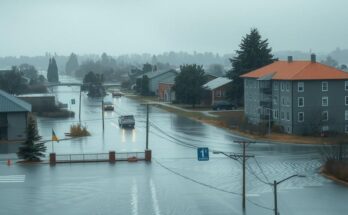Ethiopia has experienced its strongest recorded earthquake, prompting safety measures and leading to significant damage in local communities. Thousands have fled due to structural collapse, with precautionary steps underway to protect residents following volcanic activity and increased seismic activity.
In a significant geological event, residents of a locality in Ethiopia experienced a powerful earthquake, the strongest to date recorded in the region. This earthquake was centered 56 kilometers south-southeast of Abomsa and followed a previous tremor with a magnitude of 5.5, which occurred 44 kilometers northeast of Awash at a depth of 10 kilometers. In response to the devastation, Abdulla Ali, a senior administrator of Gabi Rasu area, stated that precautionary measures have been initiated to protect both local inhabitants and those displaced to temporary shelters due to extensive damage to their residences.
The recent volcanic eruption in the Gabi Rasu area was preceded by a series of increasingly intense earthquakes, particularly over the past week. The affected communities in Segento Kebele, located in the Dulecha district near the Kessem dam and Kessem sugar factory, have reported significant structural damage to both homes and educational institutions, notably the Ungaytu school situated in Sabure Kebele. Witness accounts highlight alarming changes in the environment, including cracked asphalt and ground fissures allowing water to seep through.
According to the Addis Standard news agency, the continuous seismic activity in Awash Fentale has led to the collapse of more than 30 houses, forcing thousands of residents to evacuate to adjacent regions for safety. The situation continues to evolve as local authorities work diligently to assist the affected populations while monitoring seismic activity closely.
Ethiopia’s geographical setting makes it prone to volcanic and seismic activities. The region has a history of eruptions and earthquakes, which can cause significant destruction to communities, infrastructure, and livelihoods. The recent seismic events are not isolated; rather, they are part of a broader pattern of geological activities experienced in the area. As the region grapples with these natural challenges, local leaders are taking proactive measures to ensure the safety and welfare of the affected populations, while documenting the changes in geographical conditions due to these catastrophic events.
In summary, the recent volcanic eruption and the strongest earthquake recorded in Ethiopia’s region have brought severe hardships to local communities, compelling thousands to evacuate and prompting authorities to undertake safety measures. The extent of destruction to homes and schools underscores the urgent need for continued monitoring and support for those impacted. The series of earthquakes serve as a reminder of the geological volatility of this region and the importance of preparedness to mitigate future impacts.
Original Source: www.plenglish.com




